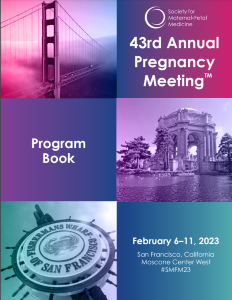Back
Oral Concurrent Session 6 - Medical Complications
Oral Concurrent Sessions
Expedited Sessions
63 - Adverse pregnancy outcomes in a contemporary cohort of pregnant people with Hepatitis C infection
Friday, February 10, 2023
2:15 PM – 2:30 PM
Location: Room 3018, Moscone West, Level 3
Objective: To evaluate the risks of adverse maternal and neonatal outcomes associated with Hepatitis C infection (HCV) in pregnancy.
Study Design: This is a secondary analysis of a multicenter prospective cohort study of of pregnant people with HCV. Participants with serum antibody test positive for HCV and 2 controls per case matched by gestational age (+/- 2 weeks) with available delivery data were included. Maternal outcomes included gestational diabetes, any reported bleeding during pregnancy, preeclampsia or gestational hypertension, cholestasis, and preterm delivery. Neonatal outcomes included hyperbilirubinemia, admission to neonatal intensive care (NICU), small for gestational age (SGA), and neonatal infection defined as sepsis or pneumonia. Models were adjusted for maternal age, body mass index, injection drug use, and maternal medical co-morbidity.
Results: Overall, there were 249 cases matched to 486 controls. There were significant differences in multiple demographic characteristics between the groups, including race, socioeconomic markers, education, insurance status, and drug and tobacco use. The frequency of maternal outcomes of gestational diabetes, preeclampsia, and bleeding during pregnancy were similar between cases and controls; cholestasis analysis was limited by low event frequency (TABLE). Preterm birth was not more frequent among cases but neonates born to cases were more likely to be admitted to the NICU (adjusted relative risk (aRR) 1.99, 95% confidence interval (CI) 1.54 – 2.58) and be SGA ( < 5th percentile: aRR 2.72, 95% CI (1.38 - 5.34). There was no increased risk of hyperbilirubinemia or neonatal infection.
Conclusion: Despite no increased risk of preterm birth or other adverse maternal outcomes in adjusted analyses, neonates born to people with HCV have more than double increased risk of NICU admission and near triple increased risk of SGA < 5th percentile.
Study Design: This is a secondary analysis of a multicenter prospective cohort study of of pregnant people with HCV. Participants with serum antibody test positive for HCV and 2 controls per case matched by gestational age (+/- 2 weeks) with available delivery data were included. Maternal outcomes included gestational diabetes, any reported bleeding during pregnancy, preeclampsia or gestational hypertension, cholestasis, and preterm delivery. Neonatal outcomes included hyperbilirubinemia, admission to neonatal intensive care (NICU), small for gestational age (SGA), and neonatal infection defined as sepsis or pneumonia. Models were adjusted for maternal age, body mass index, injection drug use, and maternal medical co-morbidity.
Results: Overall, there were 249 cases matched to 486 controls. There were significant differences in multiple demographic characteristics between the groups, including race, socioeconomic markers, education, insurance status, and drug and tobacco use. The frequency of maternal outcomes of gestational diabetes, preeclampsia, and bleeding during pregnancy were similar between cases and controls; cholestasis analysis was limited by low event frequency (TABLE). Preterm birth was not more frequent among cases but neonates born to cases were more likely to be admitted to the NICU (adjusted relative risk (aRR) 1.99, 95% confidence interval (CI) 1.54 – 2.58) and be SGA ( < 5th percentile: aRR 2.72, 95% CI (1.38 - 5.34). There was no increased risk of hyperbilirubinemia or neonatal infection.
Conclusion: Despite no increased risk of preterm birth or other adverse maternal outcomes in adjusted analyses, neonates born to people with HCV have more than double increased risk of NICU admission and near triple increased risk of SGA < 5th percentile.

Brenna L. Hughes, MD (she/her/hers)
Associate Professor
Duke University Medical Center
Durham, North Carolina, United States

.png)
